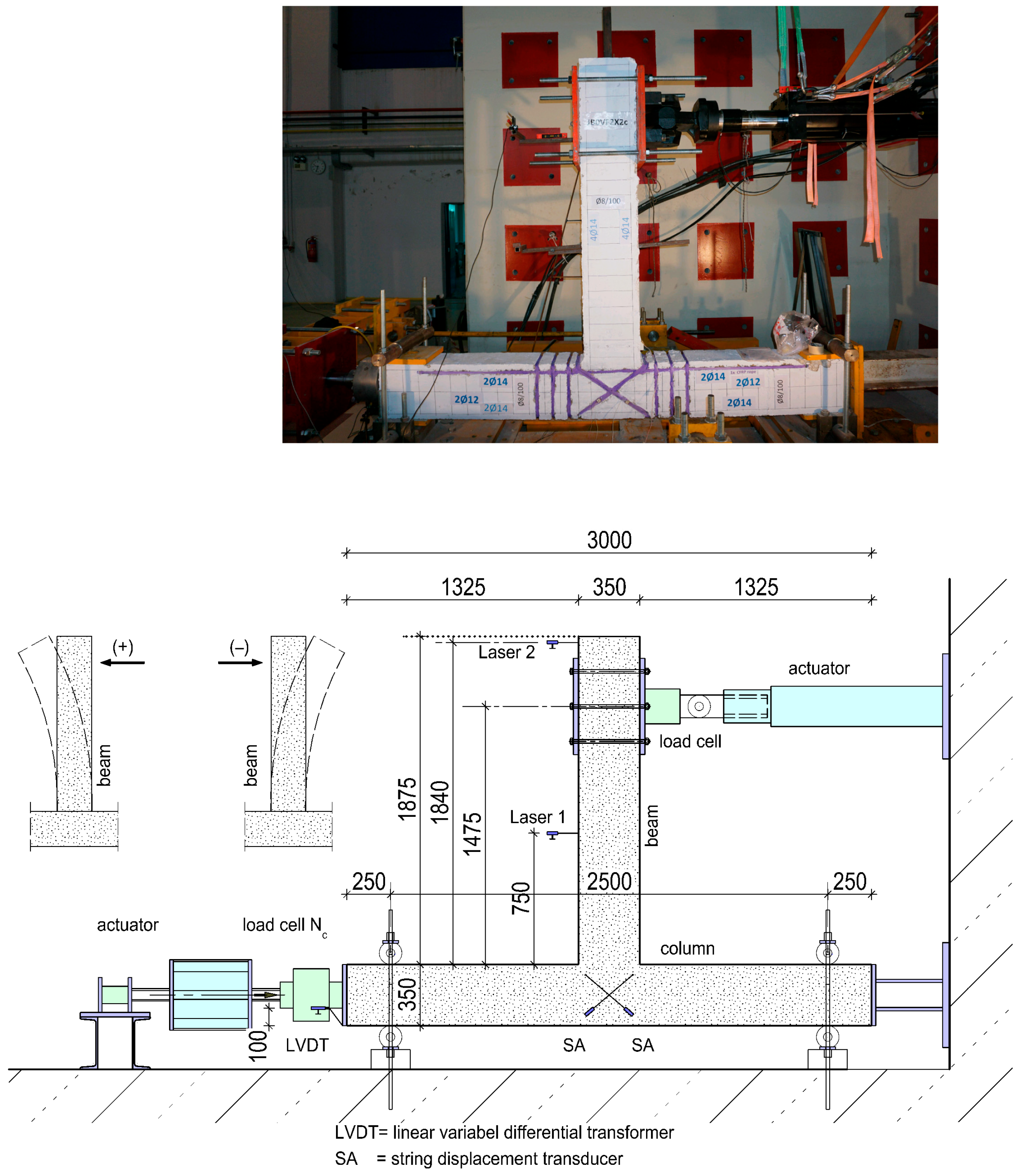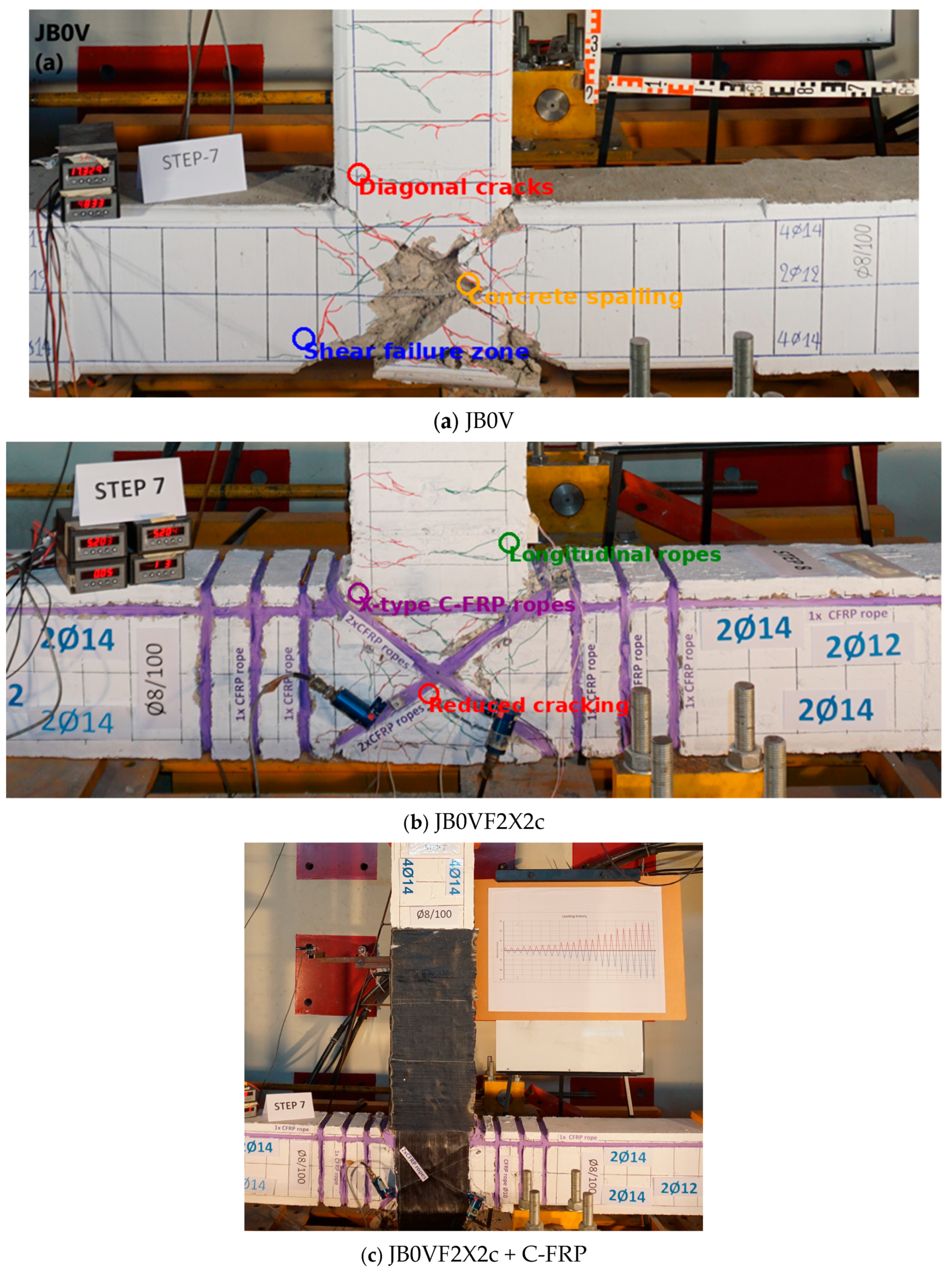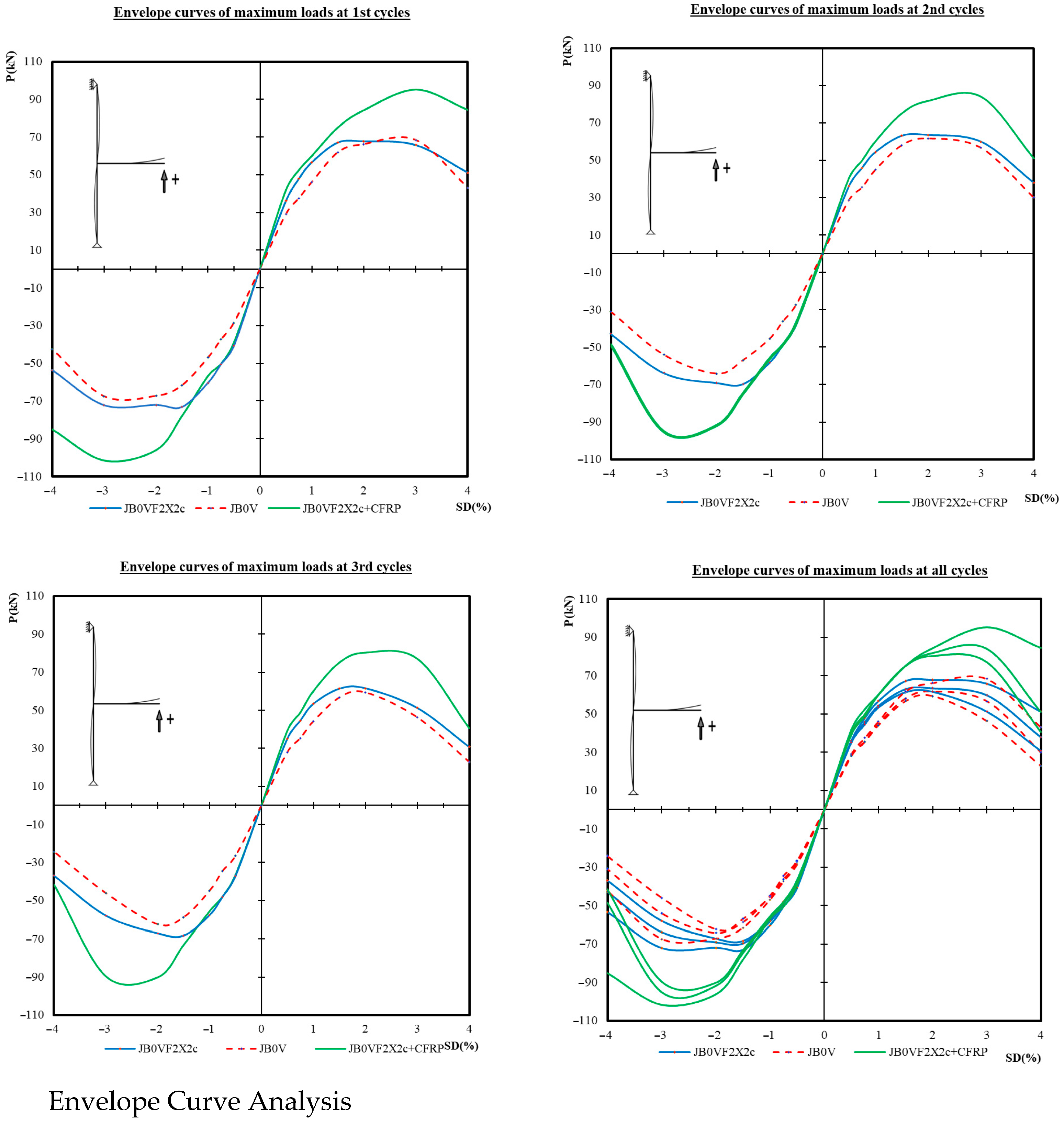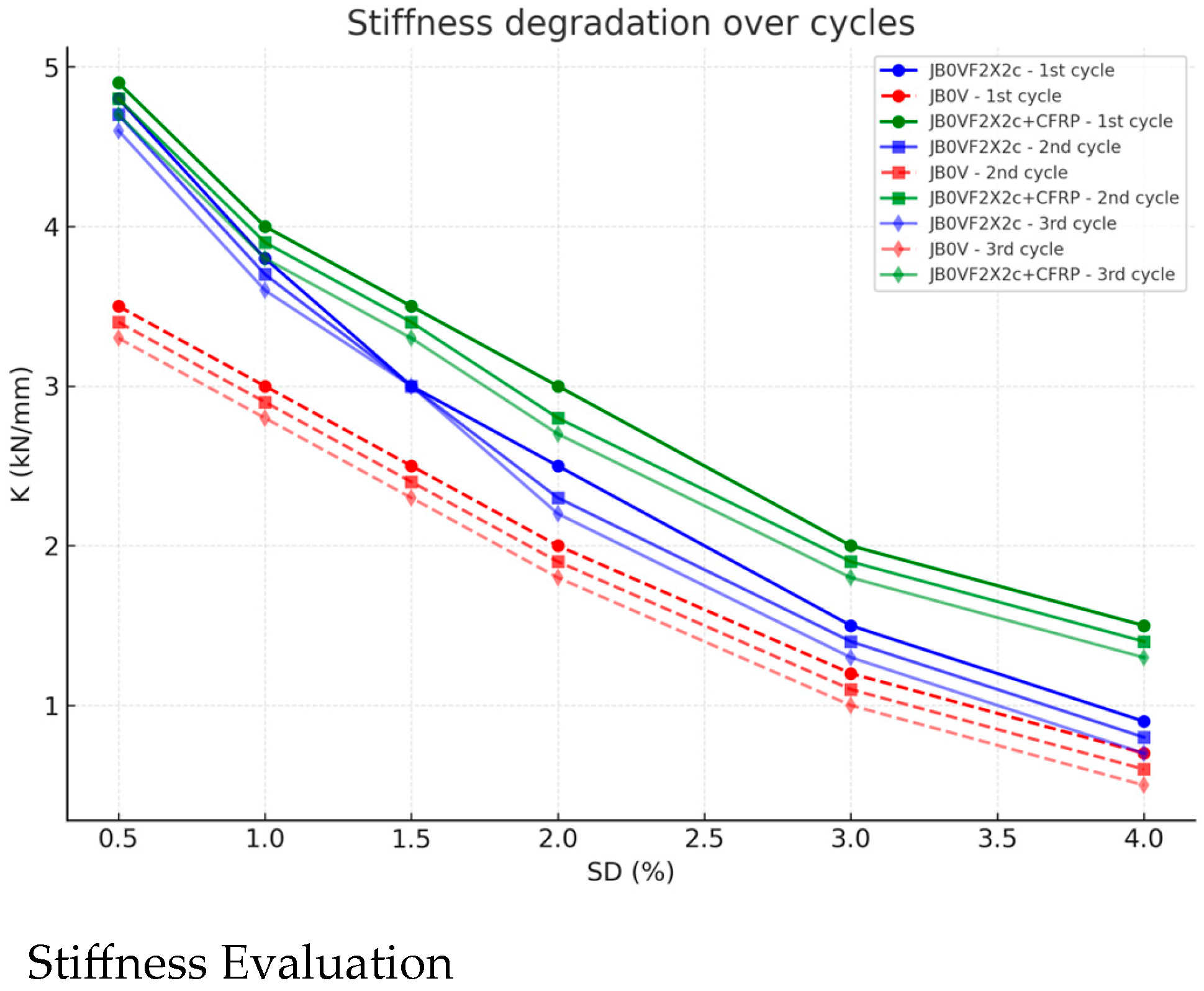4. Test Results and Hysteretic Responses
The analysis of the hysteresis curves (P–D) [
10,
14,
24] of specimens JB0V, JB0VF2X2c, and JB0VF2X2c + CFRP highlights clear distinctions in their mechanical behavior under cyclic loading, with respect to load-bearing capacity, deformability, and stiffness. A comparative assessment of the results follows (
Figure 5).
The JB0V specimen, serving as the control specimen, demonstrated significantly lower load-bearing capacity, with reduced peak load (P) values in both positive and negative directions. The hysteresis loops appear narrow, indicating limited energy dissipation capability and low ductility. Furthermore, early degradation of load resistance was observed as the loading cycles progressed.
In the JB0VF2X2c specimen, which was retrofitted with X-type C-FRP ropes embedded within the joint and anchored along the column edges (one rope per corner), a significantly enhanced mechanical response was observed. The load-bearing capacity was notably higher compared to the JB0V specimen, while the hysteresis loops were wider and more effective in dissipating energy [
9]. The specimen exhibited improved deformability without abrupt strength degradation, and the resistance distribution remained consistent throughout the deformation range [
19].
The JB0VF2X2c + C-FRP specimen incorporated combined strengthening, with both X-type C-FRP ropes at the joint and vertical ropes along the column, in addition to externally bonded C-FRP sheets along the beam. This configuration resulted in optimal overall performance [
2,
8,
15,
25]. The highest peak loads were recorded, reaching up to ±90 kN, and the hysteresis loops were broader and denser, indicating a superior energy dissipation capacity. The structural system exhibited high ductility and retained mechanical integrity under repeated seismic-type loading. Moreover, the delay in stiffness degradation further confirmed the effectiveness of the applied retrofitting scheme [
16,
18,
20].
In summary, the use of X-type C-FRP ropes (JB0VF2X2c) improved the shear behavior by over 40% compared to the unstrengthened specimen. The additional beam strengthening with externally bonded C-FRP sheets (JB0VF2X2c + C-FRP) further enhanced the system’s overall capacity and deformability. The general shape of the hysteresis loops suggests that the retrofitted specimens are better suited to withstand repeated seismic actions, offering increased safety margins and reduced mechanical deterioration over time.
At the final loading stage (Step 7), the observed damage patterns revealed significant differences in the structural performance of the three specimens. For the reference specimen JB0V (
Figure 6a), severe material degradation was evident in the joint core, with pronounced concrete crushing and spalling. The specimen experienced complete shear failure, as indicated by irregular and discontinuous diagonal cracking across the joint region. The cracks were widespread and dense in both the beam and the joint body, signifying severe to extensive structural damage. The absence of any confinement or reinforcement mechanism led to low energy dissipation and poor ductility [
21].
Specimen JB0VF2X2c, which was strengthened with internal X-shaped C-FRP ropes within the joint and vertical ropes along the column edges (
Figure 6b), exhibited a notably improved damage profile. Cracking was reduced and more uniformly distributed. The reinforcement configuration appeared effective in controlling the progression of shear failure. No signs of concrete crushing, material loss, or delamination were recorded. The joint maintained its integrity, and the damage level was assessed as minor to moderate.
In specimen JB0VF2X2c + C-FRP, where a combined retrofit strategy was applied—including internal C-FRP X-ropes and vertical ropes along the column, as well as externally bonded C-FRP sheets on the beam (
Figure 6c)—the structure remained largely undamaged. The surface showed no visible diagonal cracks or distress, and the element preserved its cohesion. The combined retrofit ensured excellent confinement and integrity, with the C-FRP sheet on the column significantly contributing to stiffness retention and damage suppression. The overall damage level was classified as negligible.
In conclusion, the progressive application of retrofit techniques from specimen JB0V to JB0VF2X2c + C-FRP resulted in a clear enhancement in mechanical behavior and substantial reduction in joint and beam damage. The use of X-shaped C-FRP ropes in JB0VF2X2c provided significant improvement over the unretrofitted control specimen, while the additional application of bonded C-FRP sheets on the beam in JB0VF2X2c + C-FRP led to optimum seismic performance, preserving the structural integrity even under the most demanding cyclic loading conditions. The fully retrofitted system demonstrated enhanced resilience, superior energy dissipation, and increased seismic reliability.
The following four diagrams illustrate the cyclic loading behavior of the specimens, presenting the maximum applied force (P) as a function of the relative displacement (story drift—SD). The assessment at each loading stage is summarized below (
Figure 7).
The cyclic load–displacement response of the three tested specimens revealed clear differences in both load-bearing capacity and seismic performance. The fully strengthened specimen JB0VF2X2c + C-FRP consistently exhibited the highest peak strengths, reaching approximately ±90 kN as early as the first loading cycle. Compared to the unstrengthened JB0V, these values represent increases of about 39% in the positive and 51% in the negative branch of the first cycle, 36% and 48% in the second cycle, and 35% and 44% in the third cycle, respectively. The ability to sustain such high loads at large displacements, without significant degradation, underscores the effectiveness of combining internal X-type C-FRP rope reinforcement within the joint with externally bonded C-FRP sheets along the beam.
The JB0VF2X2c specimen, reinforced solely with X-type ropes, also showed a measurable improvement over JB0V, particularly at story drift values exceeding 1%. Peak strength gains ranged from 2% to 4% in the positive branch and 8% to 10% in the negative branch, although the maximum load capacity was reached at smaller drifts (around 1.5–2%), which limits performance under larger deformations [
8].
As cyclic loading progressed, these trends became more pronounced. In the second cycle, JB0VF2X2c + C-FRP maintained high resistance across the entire drift range, with a widening gap between its envelope curve and that of JB0V. By the third cycle, its superiority was even more evident, as stiffness and strength degradation remained limited. In contrast, JB0V experienced a marked reduction in capacity and stiffness, particularly under repeated loading, consistent with cumulative internal damage.
The cumulative response across all cycles confirms that JB0VF2X2c + C-FRP outperforms the other two specimens in every evaluation criterion—peak strength, ductility, stiffness retention, and cyclic energy dissipation. While JB0VF2X2c also showed consistent gains over the unstrengthened specimen, its performance did not match that of the combined strengthening method. JB0V displayed a much narrower force range, rapid strength degradation, and poor hysteretic behavior, indicating limited suitability for seismic applications [
8,
25].
Overall, the results demonstrate that C-FRP strengthening, particularly the combined use of internal ropes and external sheets, is a highly effective retrofit strategy for critical RC beam–column joints. This approach delivers substantial improvements in seismic resilience and provides a reliable means of enhancing the safety of existing structures subjected to earthquake loading [
25]. The following diagrams (
Figure 8) present the dissipated energy [
22] per loading cycle (1st, 2nd, and 3rd) as a function of the story drift ratio (SD (%)) for three specimens: JB0V, JB0VF2X2c, and JB0VF2X2c + C-FRP.
The analysis of the dissipated energy (E) diagrams for the first three loading cycles confirms the beneficial effect of strengthening techniques on the energy absorption capacity of the tested specimens under cyclic loading. In the first cycle, specimen JB0VF2X2c + C-FRP, strengthened with X-type C-FRP ropes within the column joint and externally bonded C-FRP sheets along the beam, exhibits the highest energy dissipation values, outperforming the [
24,
25] unstrengthened reference specimen JB0V by approximately +85.7% and the ropes-only specimen JB0VF2X2c by +62.5% at peak load levels. JB0VF2X2c also achieves a +14.3% improvement over JB0V, demonstrating that even partial strengthening significantly enhances the cyclic energy dissipation capacity.
During the second cycle, although an overall reduction in dissipated energy is recorded for all specimens—reflecting the cumulative effects of cyclic loading and progressive material degradation—JB0VF2X2c + C-FRP continues to maintain a clear advantage, exceeding JB0V by +40.0% and JB0VF2X2c by +21.7%. JB0VF2X2c remains +15.0% above the reference specimen, confirming the sustained benefit of C-FRP rope strengthening even without additional external sheets [
25].
By the third cycle, deterioration effects become more pronounced. JB0V exhibits a marked reduction in energy dissipation capacity, while JB0VF2X2c retains a +12.5% advantage over the reference specimen. JB0VF2X2c + C-FRP shows a smaller relative benefit at this stage—+6.3% compared to JB0V and −5.6% relative to JB0VF2X2c—possibly indicating that the marginal advantage of external sheets decreases under extended cyclic demands, potentially due to localized debonding or reduced confinement efficiency.
Overall, the results highlight that both strengthening schemes improve seismic energy dissipation performance, with the combined use of C-FRP ropes and sheets providing the most substantial gains in the early and intermediate cycles. These findings underscore the value of integrating internal rope reinforcement with external confinement for retrofitting critical RC beam–column joints, ensuring improved stiffness retention, ductility, and durability under repeated earthquake-type loading.
The following diagrams (
Figure 9) illustrate the variation of stiffness (K) of the specimens per loading cycle as a function of the story drift ratio (SD(%)).
The analysis of the stiffness (K) diagrams for the first three loading cycles clearly shows the progressive reduction in stiffness with increasing story drift ratio (SD%), a typical response resulting from the development of cracking and the gradual deterioration of the mechanical properties under cyclic loading [
24].
In the first cycle, the JB0VF2X2c + C-FRP specimen—strengthened with C-FRP ropes on the column and C-FRP sheets along the beam—records the highest initial stiffness, exceeding 4.8 kN/mm at 0.5% SD, and maintains values above 3.0 kN/mm up to 2% SD. Even at the maximum deformation level of 4% SD, its stiffness remains around 1.6 kN/mm, indicating strong resistance to degradation. The JB0VF2X2c specimen, reinforced only with X-type C-FRP ropes, follows closely at low drifts (around 4.7 kN/mm at 0.5% SD) but experiences a more pronounced drop beyond 2% SD, stabilizing near 1.0 kN/mm at 4% SD. The unstrengthened reference specimen JB0V starts significantly lower, at about 3.4 kN/mm for 0.5% SD, and declines sharply to below 0.7 kN/mm at 4% SD, demonstrating its limited ability to sustain stiffness under increasing deformation demands.
In the second cycle, stiffness decreases for all specimens due to cumulative damage; however, JB0VF2X2c + C-FRP retains a clear advantage, particularly in the range of 2–4% SD. JB0VF2X2c remains in the intermediate position, while JB0V continues to present the lowest stiffness, with its curve lying distinctly below the other two.
By the third cycle, degradation becomes more pronounced. JB0VF2X2c + C-FRP still maintains the highest residual stiffness values—over twice those of JB0V at large drifts—highlighting its capacity to limit stiffness loss over repeated cycles. JB0V, on the other hand, exhibits stiffness values approaching zero at 4% SD, effectively signaling a complete loss of lateral load-bearing capacity.
Overall, the results confirm that composite C-FRP strengthening, whether in the form of internal ropes or combined with external sheets, significantly improves both the initial stiffness and its retention under cyclic demands. The combined strengthening scheme applied to JB0VF2X2c + C-FRP proves the most effective, offering greater resilience against stiffness degradation and enhancing the seismic performance of RC beam–column joints.
Below are the diagrams (
Figure 10) illustrating the evolution of the damage index as a function of the story drift ratio (SD%) for the first three loading cycles.
The analysis of the diagrams illustrating the evolution of the damage index (DI) in relation to the story drift ratio (SD%) over the first three loading cycles highlights the progressive deterioration of the specimens under cyclic loading. In all cases, DI increases gradually with increasing SD, reflecting the cumulative nature of damage within the cross-section [
24].
During the first cycle, JB0VF2X2c + C-FRP records the highest DI values, especially beyond 2.5% SD. This trend does not necessarily imply inferior performance but is associated with the specimen’s enhanced ability to dissipate energy, which is accompanied by more localized deformations. The unstrengthened specimen JB0V follows with slightly lower DI values, while JB0VF2X2c maintains the lowest rate of increase, suggesting more uniform and controlled damage development at this stage.
In the second cycle, DI values rise significantly for all specimens. JB0VF2X2c + C-FRP maintains the highest levels, following a similar trend to the first cycle. JB0V approaches the performance of the strengthened specimen, indicating teh accelerated degradation rate of its cross-section. JB0VF2X2c again shows the most restrained increase, demonstrating its ability to limit damage accumulation [
8].
By the third cycle, deterioration is more evident. DI values for all specimens range between 1.0 and 1.2, indicating severe damage. JB0VF2X2c + C-FRP still shows the highest readings, which may be linked to concentrated damage in specific regions despite retaining superior stiffness and energy dissipation capacity. JB0V reaches critical levels of damage, confirming the faster depletion of its load-bearing capacity. In contrast, JB0VF2X2c retains the lowest DI, reinforcing its role as the most resilient configuration in terms of controlling overall damage progression.
In summary, the higher DI values observed in JB0VF2X2c + C-FRP should be interpreted in the context of its improved energy absorption rather than as premature failure, while the unstrengthened specimen demonstrates the most rapid decline in performance. These findings confirm that the applied strengthening techniques—particularly the use of C-FRP ropes—play a decisive role in delaying and mitigating damage under cyclic loading. Below is the interpretation of the results from the diagram that illustrates the variation of equivalent viscous damping (%) as a function of story drift ratio (SD%) for specimens JB0V, JB0VF2X2c, and JB0VF2X2c + C-FRP (
Figure 11).
The analysis of the equivalent viscous damping (%) in relation to the story drift ratio (SD%) highlights the differences in energy dissipation capacity among the tested specimens under cyclic loading [
23]. All specimens initially show a slight reduction in damping up to approximately 1% SD, after which a progressive and more pronounced increase is observed with increasing deformation. This trend corresponds to the shift from elastic to inelastic behavior, marked by the onset of cracking, bond deterioration, localized failures, and friction between materials [
24].
At higher drift levels, distinct differences emerge. The pilot specimen JB0V records the highest damping values for SD > 3%, peaking at approximately 0.15. This reflects its earlier transition into inelastic behavior and the rapid development of damage, which increases energy dissipation but at the expense of structural integrity. JB0VF2X2c, strengthened only at the column, follows a similar but slightly lower curve, suggesting that partial strengthening improves stiffness and delays—but does not prevent—the onset of intense inelasticity [
25].
In contrast, the fully strengthened specimen JB0VF2X2c + C-FRP, reinforced both at the column and beam, maintains the lowest damping up to around 2.5% SD. This indicates a delayed activation of damage mechanisms, consistent with its higher initial stiffness and improved elastic range. Beyond this point, its damping increases sharply, matching the other specimens at 4% SD, but with a more controlled damage progression.
Overall, JB0V dissipates energy mainly through uncontrolled damage at large deformations, whereas JB0VF2X2c + C-FRP achieves comparable damping levels only after sustaining a wider elastic range, thus preserving structural capacity for longer. The comparison confirms that the combined use of C-FRP ropes and sheets can delay the onset of severe inelastic phenomena, is improving seismic resilience and maintaining performance over multiple loading cycles. It should be noted that in a previous study by the same research group, finite element simulations were conducted to investigate the mechanical behavior of reinforced concrete joints strengthened with X-shaped CFRP ropes. In these works, the ABAQUS software (Dassault Systèmes SIMULIA, Johnston, RI, USA, Version 2017) was employed to develop detailed joint models and generate stress distribution cloud maps that illustrate the constraint mechanism of the ropes. Furthermore, the improvement in stiffness was verified theoretically through the derivation of analytical expressions based on well-established mechanics principles, with the predicted results showing good agreement with the experimental findings of the present study [
28,
29].
6. Concluding Remarks
The experimental investigation assessed the seismic performance of three full-scale RC beam–column joints under cyclic loading: an unstrengthened reference specimen (JB0V), a joint strengthened only with X-type C-FRP ropes at the joint body and ropes for flexure at the column (JB0VF2X2c), and a fully retrofitted joint combining X-type and ropes at the column with externally bonded C-FRP sheets on the beam (JB0VF2X2c + C-FRP). Regarding applicability to other joint configurations, although the present experimental program focused on exterior beam–column joints, the proposed strengthening layout can be adapted for use in interior and corner joints without fundamentally altering the technique. The system’s performance is not significantly influenced by the joint’s location within the frame, although minor adjustments to the rope anchorage arrangement may be required to ensure optimal confinement.
With respect to the technical characteristics of the materials, the complete specifications and installation details of the C-FRP ropes and sheets—including their position, diameter, cross-sectional area, tensile strength, thickness, width, and quantity per specimen—are already provided in
Section 2.1 of the manuscript and in
Table 2.
The results demonstrate that the proposed strengthening systems substantially improve structural behavior across all key performance indicators. The fully strengthened specimen JB0VF2X2c + C-FRP exhibited peak load capacities of approximately ±90 kN already in the first cycle—about 30% higher than JB0VF2X2c and over 60% higher than JB0V. Even at large drifts of 4%, it retained more than 75% of its peak strength, whereas JB0V had already lost more than 40% of its capacity at the same deformation level.
In terms of energy dissipation, JB0VF2X2c + C-FRP absorbed up to 45% more energy than JB0VF2X2c and nearly doubled the values of the reference specimen for drifts beyond 2%. This improved hysteretic performance was accompanied by delayed stiffness degradation: after the third cycle, JB0VF2X2c + C-FRP retained stiffness values around 2.6 kN/mm, compared to 1.9 kN/mm for JB0VF2X2c and less than 0.8 kN/mm for JB0V.
Damage index evolution further confirmed the benefits of the strengthening schemes. While JB0V reached critical damage levels (DI ≈ 1.0) already at 3% drift, the fully retrofitted specimen maintained DI values below 0.8 up to the same deformation, indicating a slower progression of inelastic mechanisms. The equivalent viscous damping analysis revealed that JB0VF2X2c + C-FRP achieved high damping values at large drifts in a controlled manner, delaying the onset of severe nonlinearity compared to the other specimens.
Overall, the combination of X-type C-FRP ropes within the joint and externally bonded C-FRP sheets along the beam proved to be the most effective retrofit configuration, delivering simultaneous gains in load-bearing capacity, ductility, stiffness retention, and energy dissipation. In comparison with conventional internal strengthening techniques, the proposed externally applied X-shaped C-FRP rope and sheet system offers several notable advantages. It eliminates the need for concrete removal or partial demolition, thereby avoiding dust, noise, and potential damage to existing reinforcement during intervention. The method is minimally invasive, preserving the geometry and weight of the structural members, and can be executed with reduced construction time and labor compared to internal retrofitting approaches such as additional steel reinforcement or internal FRP bars. Furthermore, the external placement of the ropes allows for continuous confinement action along the joint region without disrupting the internal steel cage, enabling improved force transfer paths and more uniform stress distribution. A qualitative cost estimate of the proposed strengthening method is provided to give the reader an overview of its economic viability compared to common upgrading techniques such as externally bonded FRP laminates or steel jacketing. Based on indicative market prices, the cost of the C-FRP rope and sheet configuration used in the present study is estimated at approximately EUR 85–110 per meter of joint length, including materials and labor, depending on the project scale and site conditions. This cost is generally lower than that of steel jacketing due to the material’s weight, welding requirements, and the need for corrosion protection—and comparable to or slightly higher than conventional FRP sheet strengthening, while offering superior stiffness retention and energy dissipation capacity. These practical benefits, combined with the experimentally confirmed improvements in strength, ductility, and energy dissipation, underline the suitability of the method for upgrading deficient RC joints in service without significant disruption to building use [
25,
26,
34,
35,
36]. The intervention is minimally invasive, does not alter the geometry or weight of the structural elements, and can be applied to existing RC frames without major service disruption. The experimental results confirm that the combined use of X-shaped C-FRP ropes and externally bonded C-FRP sheets offers a robust, efficient, and practical solution for retrofitting RC beam–column joints. Beyond the demonstrated gains in strength, ductility, stiffness retention, and energy dissipation, the method stands out for its minimal invasiveness, adaptability to different joint configurations, and economic viability. These advantages highlight its strong potential for large-scale application in seismic retrofitting programs, providing a reliable pathway to extend the service life of existing RC structures and to enhance their resilience against future earthquakes.























